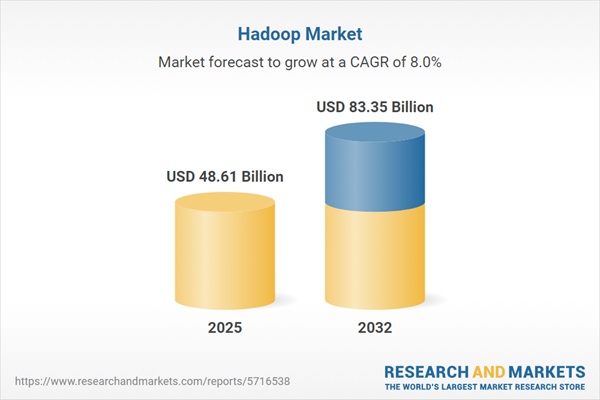Speak directly to the analyst to clarify any post sales queries you may have.
The Hadoop Market is undergoing robust transformation as enterprises worldwide seek scalable solutions for managing, processing, and deriving value from vast data resources. Senior decision-makers require actionable insights to navigate evolving deployment models, regulatory challenges, and technology innovations that influence strategic data initiatives.
Hadoop Market Snapshot
The Hadoop Market grew from USD 45.04 billion in 2024 to USD 48.61 billion in 2025. It is expected to continue growing at a CAGR of 7.99%, reaching USD 83.35 billion by 2032. Market momentum is driven by enterprise digital transformation, increased demand for big data analytics, and the adoption of cloud-centric architectures. Organizations increasingly leverage Hadoop to support data-driven strategies, bolster operational efficiency, and accelerate real-time analytics across sectors such as finance, government, healthcare, and e-commerce.
Scope & Segmentation of the Hadoop Market
This comprehensive report covers the full spectrum of the Hadoop market landscape, providing in-depth analysis across all major segments and their interplay with technology and geographic trends:
- Deployment Mode: Cloud (Hybrid Cloud, Cloud Bursting, Multi Cloud, Private Cloud, OpenStack, VMware, Public Cloud, AWS EMR, Azure HDInsight, Google Cloud Dataproc), On-Premises
- Distribution: Amazon EMR, Apache Hadoop, Cloudera, Hortonworks, IBM BigInsights, MapR
- Component: Management & Monitoring (Performance Monitoring, Resource Management, Workflow Scheduling), Processing Engines, Security & Governance (Auditing & Compliance, Data Encryption, Identity & Access Management), Storage
- Industry: Banking Financial Services Insurance, Government, Healthcare Life Sciences, Manufacturing, Media Entertainment, Retail E-Commerce, Telecommunication IT
- Organization Size: Large Enterprises, Small Medium Enterprises
- Service Type: Professional Services (Consulting, Implementation, Integration), Support Maintenance, Training Education (Certification Programs, Classroom Training, Online Training)
- Application: Big Data Analytics, Data Integration, Data Warehousing, Security Governance
- Geographies: Americas (United States, Canada, Mexico, Brazil, Argentina, Chile, Colombia, Peru), Europe, Middle East & Africa (United Kingdom, Germany, France, Russia, Italy, Spain, Netherlands, Sweden, Poland, Switzerland, United Arab Emirates, Saudi Arabia, Qatar, Turkey, Israel, South Africa, Nigeria, Egypt, Kenya), Asia-Pacific (China, India, Japan, Australia, South Korea, Indonesia, Thailand, Malaysia, Singapore, Taiwan)
- Company Coverage: Amazon Web Services, Microsoft, Google LLC, IBM, Cloudera, Oracle, Alibaba Cloud Intelligence, SAP SE, Hewlett Packard Enterprise, Teradata Corporation
Key Takeaways for Senior Decision-Makers
- Hadoop has shifted from experimental use to being pivotal in modern enterprise data architectures, enabling advanced analytics and scalable data integration.
- Hybrid and multi-cloud adoption is accelerating, with organizations adopting flexible deployment models to meet unique business priorities and regulatory requirements.
- Technology convergence—including containerization, in-memory processing, and integration with AI/machine learning—expands Hadoop’s applicability and adaptability across diverse environments.
- Vendor competition intensifies as major cloud providers, systems integrators, and open-source contributors drive innovation, offering both managed services and customizable on-premises solutions.
- Security, governance, and compliance have become central to Hadoop deployments, with enhanced auditing, encryption, and automation now standard practice.
- Regional nuances—such as regulatory mandates in EMEA and rapid digitalization in Asia-Pacific—create distinct adoption pathways, impacting investment and implementation strategies in each key geography.
Assessing United States Tariff Policy Impact
The evolving U.S. tariff landscape introduces new complexities for Hadoop deployments, particularly for organizations investing in on-premises infrastructure and specialized hardware. Increased import duties have led companies to re-evaluate supply chain strategies, with many turning to cloud-based and containerized Hadoop solutions to manage costs and risk. As a result, vendor diversification and collaborative procurement are emerging as effective responses to mitigate tariff-related challenges and supply chain disruptions.
Research Methodology & Data Sources
This analysis deploys a dual approach, integrating primary interviews with senior executives and experts alongside secondary research from white papers, vendor reports, standards bodies, and academic literature. Advanced frameworks such as SWOT, value chain analysis, and competitive benchmarking underpin segmentation and vendor evaluations. All data is rigorously validated to ensure integrity and up-to-date insight for decision-making.
Why This Hadoop Market Report Matters
- Empowers technology and business leaders to align Hadoop investments with evolving digital and regulatory landscapes.
- Illuminates critical emerging trends, technology innovations, and competitive factors shaping long-term strategy and risk management.
- Equips organizations to optimize operations, future-proof data architectures, and enhance data governance across global deployments.
Conclusion
The Hadoop market continues to evolve, shaped by innovation, regulatory shifts, and changing enterprise requirements. Strategic adoption, robust governance, and adaptable architectures are essential for capitalizing on Hadoop’s full potential as a driver of enterprise data intelligence.
Additional Product Information:
- Purchase of this report includes 1 year online access with quarterly updates.
- This report can be updated on request. Please contact our Customer Experience team using the Ask a Question widget on our website.
Table of Contents
3. Executive Summary
4. Market Overview
7. Cumulative Impact of Artificial Intelligence 2025
Companies Mentioned
The companies profiled in this Hadoop market report include:- Amazon Web Services, Inc.
- Microsoft Corporation
- Google LLC
- International Business Machines Corporation
- Cloudera, Inc.
- Oracle Corporation
- Alibaba Cloud Intelligence Co., Ltd.
- SAP SE
- Hewlett Packard Enterprise Company
- Teradata Corporation
Table Information
| Report Attribute | Details |
|---|---|
| No. of Pages | 198 |
| Published | November 2025 |
| Forecast Period | 2025 - 2032 |
| Estimated Market Value ( USD | $ 48.61 Billion |
| Forecasted Market Value ( USD | $ 83.35 Billion |
| Compound Annual Growth Rate | 7.9% |
| Regions Covered | Global |
| No. of Companies Mentioned | 11 |









